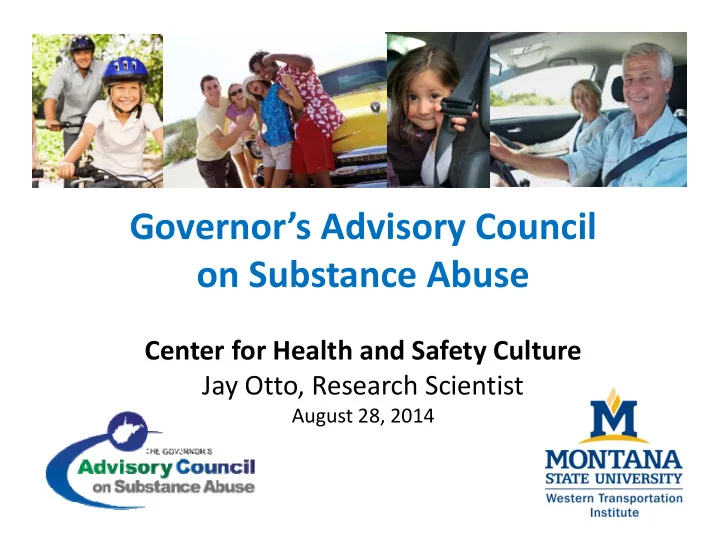

Governor’s Advisory Council on Substance Abuse Center for Health and Safety Culture Jay Otto, Research Scientist August 28, 2014
Map of PCN Projects
“Never doubt that a small group of thoughtful, committed citizens can change the world. Indeed, it's the only thing that ever has.” Margaret Mead
Agenda • Regional Task Force Survey Results • Strategic Prevention Framework Partnerships for Success Project (SPF ‐ PFS)
RTF Participant Survey 1. Beliefs about the RTFs themselves 2. Perceived Use and Trends 3. Beliefs about Prevention, Intervention and Treatment
RTF Survey Results • Most RTF participants believe reducing substance abuse in WV is extremely important • They also believe others think it is important – But not necessarily to the same degree
RTF Survey Results Beliefs about the Task Forces • Most RTF participants believe substance abuse can be reduced. • Most RTF participants agree the Regional Task Forces have made significant contributions. • Most RTF participants have been engaged and are likely to stay engaged in RTF activities.
RTF Survey Results Perceived Use and Trends Tobacco 72% RTF participants believed about half or more of WV adults smoke. About 28% of adults smoke
RTF Survey Results Perceived Use and Trends Alcohol 57% RTF participants believed alcohol use by WV high school students has increased in the past 15 years. It has decreased . About 34% drink monthly
RTF Survey Results Perceived Use and Trends Prescription Drugs 58% RTF participants believed about half or more of WV adults have taken a prescription drug that was not prescribed to them. About 4% have used a prescription pain reliever for non ‐ medical use in the past year. Source: NSDUH, 2011 ‐ 12, Table 8 – Nonmedical Use of Pain Relievers in the Past Year, www.samhsa.gov/data/NSDUH/2k12State/CountTabs/NSDUHsaeCountTabs2012.htm
RTF Survey Results Beliefs about Prevention, Intervention and Treatment RTF participants recognized ‐ that prevention, intervention and treatment work! ‐ Want to learn more about prevention strategies!
RTF Survey Results Complete results available online at www.wvsubstancefree.org under Resources
WV Strategic Prevention Framework Partnerships for Success Grant • 5 year project • All Prevention Regions – 2 counties in each region • Underage Drinking (age 12 ‐ 20) / Prescription Drug Abuse (age 12 ‐ 25)
Successful Project First, meaningful purpose Then, develop clear understanding Finally, focused and effective action
Purpose Develop effective prevention strategies Build sustainable prevention infrastructure
If you came upon a river, and fish were dying, what would you do?
Underage Drinking Prevention Model Source: Pacific Institute for Research and Evaluation (PIRE), Prevention of Underage Drinking: Logic Model Documentation, 2/8/2008
Transforming the Approach Before “How do I get youth not to drink?” Now “What actions do I want to grow across the social ecology to reduce underage drinking?”
Center for Health and Safety Culture Improving Health and Safety Growing positive community norms Cultivating cultural transformation
Core Assumption The POSITIVE exists and is worth growing.
Culture Individual
Positive Community Norms Framework Leadership Individuals Increase Positive Community Families Norms Communication Peers Schools Improve Health Workplaces & Safety Cultural Integration Transformation Communities
Positive Community Norms Framework Core Tenets Improving health and safety involves ‐ Growing positive community norms ‐ Cultivating cultural transformation
Positive Community Norms Framework Core Tenets Improving health and safety involves ‐ Multiple strategies across the social ecology ‐ Youth, peers, families, schools, workplaces, law enforcement, elected officials, etc.
Positive Community Norms Framework Core Tenets Improving health and safety involves ‐ Leadership ‐ Convey a vision of hope and concern ‐ Foster change and transformation
Positive Community Norms Framework Core Tenets Improving health and safety involves ‐ Communication ‐ Closes gaps in understanding ‐ Tells a new story in our communities
Positive Community Norms Framework Core Tenets Improving health and safety involves ‐ Integration ‐ Multiple strategies that span the social ecology and the continuum of care ‐ Alignment of strategies to enhance effectiveness
What’s Coming… • Developing common language and understanding • Exposing the Positive Norms in West Virginia – Surveys • School • Law Enforcement • Community / Parent
The solutions are in the community.
Ways I can help… • Answer questions • Provide presentations, trainings, etc.
Actions YOU Can Take • Speak up and claim who we are – NOT who we are perceived to be • Use your influence to open doors • Take a long ‐ term perspective
“Never doubt that a small group of thoughtful, committed citizens can change the world. Indeed, it's the only thing that ever has.” Margaret Mead
Recommend
More recommend